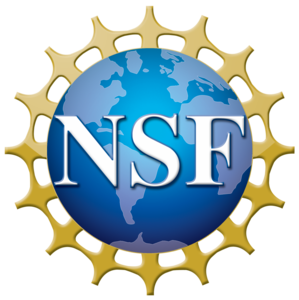Student Poster Abstracts
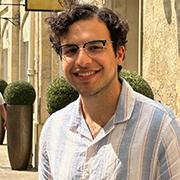 Amer Al-Hiyasat Massachusetts Institute of Technology  |
Dynamics of a cold particle in a hot bathWe study the dynamics of a zero-temperature, overdamped tracer particle in a bath of Brownian particles at temperature T. At low bath densities, the tracer exhibits nonequilibrium behavior reminiscent of active particles, including wall accumulation and the emergence of ratchet currents in asymmetric potentials. As the bath density increases, these effects vanish and the tracer equilibrates to a Boltzmann distribution at temperature T. We develop an explicit model of the tracer-bath interactions that can be solved in the thermodynamic limit and determine the conditions under which this effective equilibrium picture emerges. We discuss applications to multi-temperature systems and to the dynamics of passive objects in active baths. |
|
 Pragya Arora Brandeis University  |
Programmable icosahedral capsids: A layered approach mediated by lipid templatesSelf-assembly is a fundamental process in both inanimate and animate systems, where subunits spontaneously organize into structured assemblies. Spanning from lipid membranes to multiprotein filaments, this self-organization is crucial for numerous biological functions. A striking example is the assembly of protein subunits around viral nucleic acids to form protective capsids. Over 50 years ago, the Caspar and Klug theory of quasi-equivalence provided seminal insight into viral capsid structure, observing that most spherical viruses exhibit icosahedral order. While this theory describes the structure of many smaller spherical viruses, larger viruses such as herpes simplex virus assemble in layers and require a template for successful assembly. Despite extensive studies on the spontaneous assembly of viral proteins into empty capsid shells, the in vitro replication of templated assembly around a rigid spherical template remains unexplored. Here, we aim to construct large capsids with high yield using a minimal number of building blocks, inspired by the layered architecture of large viruses. By utilizing a spherical template to assemble capsids with a single equivalent bonding interaction, we propose an experimental strategy that mimics this natural design. This approach employs engineered lipid vesicles with cholesterol-modified DNA as the inner layer and triangular-shaped DNA origami building blocks as the outer layer. We developed a single-molecule microscopy assay to investigate the kinetics of DNA origami self-assembly on lipid bilayers using Total Internal Reflection Fluorescence (TIRF) microscopy. Furthermore, we devised a method to obtain quantitative estimates of triangle-lipid binding interactions through flow cytometry on lipid-coated colloids. This comprehensive approach promises to significantly enhance the yield of origami capsids, potentially by several orders of magnitude compared to current methods. |
|
 Subhaya Bose University of California, Merced |
Analysis of elastic strains reveals shape selection pathways in active gelsMyosin motor-induced forces in the actin cytoskeleton are responsible for cell and tissue shape changes in living systems. We consider in vitro experiments where a set of actomyosin gel disks spontaneously contract and buckle into a family of initial-geometry dependent, 3D shapes ranging from domes to wrinkled [1]. We perform particle imaging velocimetry (PIV) analysis on gels of different initial shapes to obtain the in-plane distribution of elastic strains. Resolving the radial and azimuthal components of strain reveals the robust occurrence of an inner isotropic contracting region, surrounded by an outer region with radial stretching. Comparison with a model for active stresses in elastic disks allows us to infer an outer region with aligned force dipoles representing myosin activity. Our findings support the hypothesis that this differential distribution of active stresses arises from the contraction-induced local alignment of actin bundles along the gel boundary. Future work will reveal how the in-plane strain distribution determines the final 3D buckled shapes. 1. “Artificial contractile actomyosin gels recreate the curved and wrinkling shapes of cells and tissues” by G. Livne et al., biorXiv 2023.03.21.533327. No poster image available as this presentation involves work yet to be published. |
|
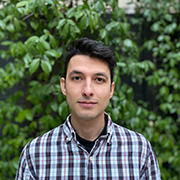 Paulo Casagrande Godolphim Universidad de Chile  |
Mechanical Heterogeneity in Fish EmbryosTissue mechanics is essential for animal development, yet the precise manner in which mechanics determine the fate of embryonic tissue is not fully understood. Our system of interest is the enveloping cell layer (EVL) of an Annual Killifish embryo during the epiboly stage (11-22 hpf), at which the EVL exhibits a wide and heterogeneous apical cell area size distribution. In this study, we employ a technique called micromechanics to infer mechanical fields, explore tissue heterogeneity, and construct quantitative-based models directly from experimental images. Applying micromechanics to a vertex model, we demonstrate that the experimental area distribution can only be reproduced with a tissue exhibiting heterogeneous mechanical properties. The heterogeneity in the model tissue is characterized by larger cells being softer than smaller ones. This correlation allows us to write functional relations between the model parameters and the experimental tissue geometry, which were used to construct new energy functional candidates for the tissue. Simulations suggest that promoting cell intrusion via chemical activation is a viable experimental assay to confirm the heterogeneous properties of embryos. Here, the area strain versus cellular area is the critical observable quantity, where, counterintuitively, a heterogeneous tissue should exhibit a flat response while in a homogeneous tissue, larger cells should deform more. We discuss the potential implications of these heterogeneities on the fate of the tissue and how they could act to reduce stress on the cell layer, potentially serving as an important evolutionary mechanism for the survival of the animal. Additionally, micromechanics can be applied to a wide range of experiments and models, making it a valuable technique for future studies |
|
 Santiago Gomez Melo Ruprecht-Karls Universitaet Heidelberg  |
Alignment and Actuation of Liquid Crystals via 3D Confinement and Two-Photon Laser PrintingLiquid crystalline elastomers (LCEs) are a promising class of material to achieve autonomous deformation in response to external stim- uli. Their actuation stems from the nematic-isotropic transition of a programmed molecular orientation, in which the LCE locally strains differently along the parallel and perpendicular directions. Recently, interest in this system has increased due to the possibility to 3D-print such materials as structures with arbitrary shapes. Here we show that the orientation in the sample can be controlled by positioning PDMS- scaffolds at the boundaries. Because they introduce strong anchoring boundary conditions, they determine the minimal energy solution of the Landau-de Gennes free energy of the LCE. We show both theoret- ically and experimentally that the use of suitable scaffold geometries allows for the engineering of diverse textures of the director field, which are then imprinted into the LCE by direct laser writing. To demon- strate successful design, we show that the calculated and measured birefringence patterns agree very well with each other. A similar test can be performed for mechanical actuation by temperature changes, which is predicted by modelling the LCE-microdevice as neo-Hookean material with an active deformation contribution. |
|
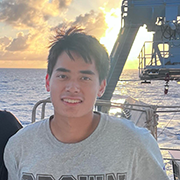 Ian Ho Stanford University  |
Self-learning mechanical circuitsDynamical self-adaptivity and embodied computation are ubiquitous in living systems, from cytoplasm and biofilms to animal flocks. Despite recent progress in such material computation, the problem of designing mechanical systems which self-learn remains poorly understood. Here we introduce the concept of self-learning mechanical circuits, which use mechanical inputs from changing environments to continually update their internal state, thus representing an entirely mechanical information processing unit. Our circuits are composed of a new mechanical construct: an adaptive directed spring (ADS), which executes neural network-like computations mechanically. We demonstrate the capacity of mechanical circuits to self-learn using both theoretical modeling and experimental realizations. Our results pave the way towards the construction of energy-harvesting, adaptive materials which can autonomously and continuously sense and self-optimize to gain function in different environments. |
|
 Ayanna Matthews University of Chicago  |
Trainable Materials With Internal PrestressDisordered materials are great candidates for trainable materials due to their varied and uncorrelated response to different types of deformations. We use disordered spring network models to test the trainability of disordered materials for specific mechanical functions, but thus far these models have not considered internal stress. We want to add internal prestress into our models, because most materials—including living materials with active internal stresses—have significant amounts of prestress. Using this model, I test the limits of trainability in materials with internal prestress. Results show that with increased prestress, our training method cannot just rely on how much stress or change in stress each component feels, but must also now consider how each reorients under deformation. This provides insight into how materials experiencing prestress might be trained and sets limits based on possible training protocols. |
|
 Carlos Moguel Syracuse University  |
Topological Frustration in Twisted, Elastic SheetsThe complicated interplay of elasticity and topology makes it difficult to build a robust picture of how topology affects the rigidity and elastic response of thin shells. When the underlying sheet is a Möbius strip, a new topological effect, dubbed non-orientable order, induces a history-dependent response to applied forces studied in an effective one-dimensional model. How to extend this formulation to topologically nontrivial 2D sheets, however, remains elusive. We construct a 2D elastic theory for the low-energy excitations of orientable and non-orientable elastic ribbons within the framework of non-Euclidean elasticity. This formulation naturally extends the idea of non-orientable order to two-dimensional thin sheets and uncovers a host of new phenomena induced by the ribbons’ topology and geometry. |
|
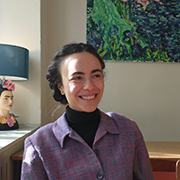 Beatrice Nettuno University of Munich  |
Phase Separation as a Mechanism for Actin TreadmillingWe demonstrate that the phase separation of a protein facilitating actin polymerization (VASP) is crucial for the treadmilling of actin filaments. Phase separation enhances the formation and stabilization of bundles, where a balance between polymerization and depolymerization (mediated by cofilin) is achieved. Outside the bundles, filaments tend to depolymerize, while inside, their growth is enhanced, leading to bundle coarsening. We predict that modulating the phase separation strength changes the treadmilling properties of the filaments, with both excessive and insufficient phase separation halting the process. Our agent-based simulations align with experimental observations, validating our theoretical predictions. |
|
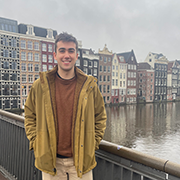 Luke Neville University of Bristol |
Controlling wall particle interactions withAbstract to come. |
|
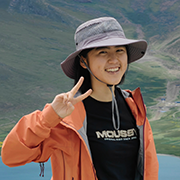 Luyi Qiu Harvard University  |
Mechanics and wrinkling patterns of pressurized bent tubesA thin-walled tube, e.g., a drinking straw, manifests an instability when bent by localizing the curvature change in a small region. Motivated by rod-shaped bacteria such as E. coli, whose cell walls are much thinner than their radius and are subject to a substantial internal pressure, we study, theoretically, how this instability is affected by this internal pressure and verify the results by a computational model. In the parameter range relevant to the bacteria, we find that the internal pressure significantly postpones the onset of the instability, while the bending stiffness of the cell wall has almost no influence. We also employ tension-field theory to describe the mechanical behaviour before and after the instability transition. |
|
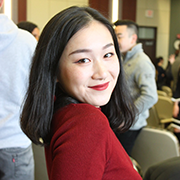 Tammy Qiu Columbia University  |
Using optogenetics to disentangle how mechanical cues coordinate cell behaviors and maintain bilateral symmetry during tissue elongationDuring Drosophila axis elongation, both global embryo-scale forces and local cell-scale forces contribute to the elongation of the germband epithelium along the anterior-posterior axis of the embryo. Divided by the invaginated mesoderm, the left and right sides of the germband extend to the same length and display a remarkable degree of symmetry at the cellular scale in terms of rearrangement rates. The co-elongation of neighboring tissues, which is a conserved symmetry-breaking mechanism in many embryos, is an understudied but interesting phenomenon that requires coordination of cell behaviors across embryonic length scales. With optogenetics, we can disentangle these relationships by inducing spatiotemporally defined biomechanical perturbations in vivo in a way that is not feasible via pharmacological or genetic interventions. Using previously described optogenetic tools that target the Rho/Rho-kinase signaling pathway and actomyosin force generation, we demonstrate a protocol for corralling optogenetic perturbation to either the left or right side of the germband epithelium while simultaneously monitoring the effects on actomyosin and cell behaviors on both sides of the embryo. Notably, we find that local optogenetic perturbation leads to disruption of myosin recruitment and planar polarity within the activated side of the embryo as well as unexpected effects in distant, unactivated regions of the embryo, such as prominent dorsal folds, which suggests coupling that contributes to overall axis elongation. These studies provide a foundation for unraveling how mechanical interaction and feedback help coordinate cell behaviors, even over long distances, to ensure robust morphogenesis and development. |
|
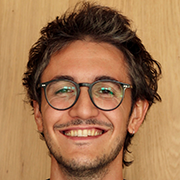 Riccardo Rossetto Max Planck Institute for Dynamics and Self-Organization  |
Phase separation in a compartment with matter exchange and dimerizationIn biological cells, patterns form in compartments of various dimensionalities. For instance, proteins form structures in biological membranes, which can be conceptualized as a two-dimensional compartment that exchanges material with the bulk cytosol. Moreover, the involved proteins often also form short polymers and interact unspecifically with each other. We describe this situation with a thermodynamically consistent minimal model, which accounts for phase separation, dimerization, and material exchange between bulk and a generic compartment. While these mechanisms are understood individually, interesting nonlinear effects emerge from their combination. We illustrate this by explaining experimental data of the PAR patterning system, where dimerization boosts membrane binding, presumably to control PAR patterns. More broadly, our general model unveils fundamental mechanisms of controlling phase separation occurring in a compartment and will help us explain more biological observations in the future. |
|
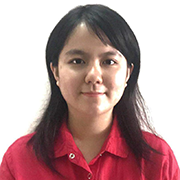 Yiwen Tang Northeastern University  |
Cell Division and Motility Enable Hexatic Order in Biological TissuesBiological tissues transform between solid- and liquidlike states in many fundamental physiological events. Recent experimental observations further suggest that in two-dimensional epithelial tissues these solid-liquid transformations can happen via intermediate states akin to the intermediate hexatic phases observed in equilibrium two-dimensional melting. The hexatic phase is characterized by quasi-long-range (power-law) orientational order but no translational order, thus endowing some structure to an otherwise structureless fluid. While it has been shown that hexatic order in tissue models can be induced by motility and thermal fluctuations, the role of cell division and apoptosis (birth and death) has remained poorly understood, despite its fundamental biological role. Here we study the effect of cell division and apoptosis on global hexatic order within the framework of the self-propelled Voronoi model of tissue. Although cell division naively destroys order and active motility facilitates deformations, we show that their combined action drives a liquid-hexatic-liquid transformation as the motility increases. The hexatic phase is accessed by the delicate balance of dislocation defect generation from cell division and the active binding of disclination-antidisclination pairs from motility. We formulate a mean-field model to elucidate this competition between cell division and motility and the consequent development of hexatic order. |
|
 Haiqin Wang Technion-Israel Institute of Technology 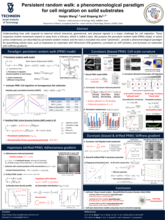 |
Persistent random walk: a phenomenological paradigm for cell migration on solid substratesCell migration is crucial to many biological processes, including embryonic morphogenesis, tissue repair, immune response, and cancer progression. Understanding how cells respond to external stimuli (chemical, geometrical, and physical signals) is a major challenge for cell migration. These responses involve movement toward or away from a stimulus, which is called a taxis. We propose the persistent random walk model, in which active randomness is described by persistent random motion and the taxis is included into some “potentials”, provide a phenomenological paradigm for quantifying cellular taxis, such as haptotaxis on substrates with fibronectin gradients, curvotaxis on stiff cylinders, and durotaxis on substrates with stiffness gradients. |
|
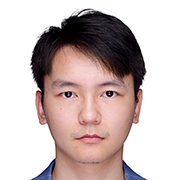 Ding Wang Hong Kong Baptist University  |
Tunable Wetting Properties in Multicomponent Protein CondensatesDrawing inspiration from experimental studies at Wei lab, we explore the tunable wetting properties of multi-component protein condensates using computer simulations and a sticker-spacer model design. Our key discovery is that the wetting behavior—specifically how protein droplets interact—can be adjusted by the strength of weak, non-specific interactions within a client protein present in the droplets. Weak interactions promote droplet contact, whereas their absence results in non-wetting behavior. Strong interactions, on the other hand, lead to droplet coalescence. Additionally, the volume fractions of these components significantly influence the resulting structures. |
|
 Cheyne Weis University of Chicago |
Non-Reciprocity Induced Avalanching in Sparse Networks of Spiking NeuronsNetworks of sparsely connected excitatory and inhibitory spiking neurons display a range of dynamical phases, from slow, irregular firing to globally synchronized activity. Neural systems have asymmetric nonreciprocal interactions between excitatory and inhibitory neurons, distinct from equilibrium models in statistical physics. To explore these dynamic phases, we approximate spiking neurons using a theta model, where nonreciprocity manifests as an angular drive that manifests the nonequilibrium properties of the model. We demonstrate that at large systems sizes the nonreciprocity between neurons and thermal noise renormalize to dominate the system beyond a critical nonequilibrium length scale, thereby eliminating inactive regimes present at finite sizes. Our findings are consistent across simpler maximum entropy models, which we use to investigate inference near the boundary between inactive and active states. We observe that the quality of inference peaks near this boundary, implying that maximal information transfer could be occurring at the crossover between phases. This suggests that neurons operating near an avalanching boundary could optimize information transfer, enhancing the ability of downstream neurons to decode stimuli from upstream neurons. |
|
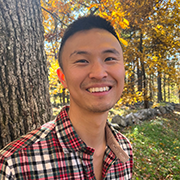 XJ Xu Yale University  |
Rhythmic contractility on multiple timescalesRhoA and Cdc42 are two Rho GTPases that play major roles in coordinating actomyosin-driven contractility in animal cells. We describe how periodic and mixed-mode RhoA oscillations with multiple timescales correlate with contractile behavior in mitotic mast cells. The transition between periodic and mixed-mode oscillations is captured with a phenomenological model. Then we show the roles and mechanisms of the phosphoinositide network underlying the RhoA oscillations. Lastly, we discuss the emergence of Cdc42 traveling waves and the associated open questions regarding the collective dynamics of RhoA and Cdc42. |
|
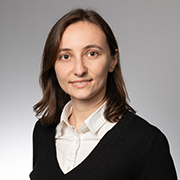 Maria Yampolskaya Boston University  |
Finding signatures of low-dimensional geometric landscapes in high-dimensional cell fate transitionsIn many animals, hundreds of highly specialized cell types work together to maintain homeostasis. When growing or injured, cells can self-organize and transition between these cell types. The consistency and robustness of developmental cell fate trajectories suggests that complex gene regulatory networks effectively act as low-dimensional cell fate landscapes. While there has been progress in characterizing classes of cell fate decisions using gradient-like dynamical systems, the theory connecting geometric landscapes to high-dimensional gene expression space is still in its infancy. In this paper, we introduce a phenomenological model of cell fate transitions that predicts bifurcation signatures observable in gene expression measurements. By combining low-dimensional gradient dynamical systems and high-dimensional Hopfield networks, our model captures the interplay between cell fate, gene expression, and signals. The signal-driven bifurcations of an input landscape control the stability of attractors, and this feature allows the model to predict dynamics resulting from any class of bifurcation. Using existing single-cell RNA-sequencing time-series data, we compare experimental observations to theoretical landscape candidates belonging to different bifurcation classes. In the developing mouse lung, the transient appearance of a mixed alveolar type 1/type 2 state in the growing mouse suggests the maturation of alveolar cells is a triple cusp bifurcation. Additionally, previous analysis of lineage-tracing data of in vitro hematopoetic differentiation indicated that monocytes have a neutrophil-like path of differentiation; when compared to possible landscapes, bipotent neutrophil-monocyte progenitors appear to undergo a heteroclinic flip bifurcation. These results show that a geometric landscape approach can reveal new insights in time series single-cell RNA-sequencing data of cell fate transitions. |

